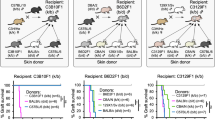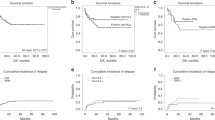Abstract
THE mouse H-2 locus and its genetic homologue, the HL-A locus in man, are much more complex than originally envisaged, and are now referred to as the major histocompatibility complex (MHC)1. Transplant rejection is more closely correlated with mixed lymphocyte reaction (MLR) than with tissue typing2–6 and in addition to an MLR region in the MHC other regions are of obvious importance in the context of recognition, for example the immune responsiveness regions (Ir)7,8. The only gene products of the MHC so far characterised are those recognised serologically by ‘tissue typing’ antisera, that is, H-2 antigens and their homologues in other species. These products are not the only substances involved in the fate of allografts; indeed sensitisation against an allograft seems to require MLR differences although serologically detected components have an, as yet undefined, role in the effector arc of rejection9–11. Though there are suggestions that MHC gene products other than H-2 (HL-A, and so on) may be primarily involved in graft rejection12, the only in vivo studies pointing strongly in that direction were carried out in the rat enhancement model13. In these studies rat heart allografts were passively enhanced by alloantisera from which Ag-B (the H-2 homologue in rats) antibodies had been removed by absorption with appropriate red blood cells (RBC), which suggests a role for antibodies directed against other products of the MHC.
This is a preview of subscription content, access via your institution
Access options
Subscribe to this journal
Receive 51 print issues and online access
$199.00 per year
only $3.90 per issue
Buy this article
- Purchase on Springer Link
- Instant access to full article PDF
Prices may be subject to local taxes which are calculated during checkout
Similar content being viewed by others
References
Yunis, E. J., and Amos, D. B., Proc. natn. Acad. Sci. U.S.A., 68, 3031–3035 (1971).
Demant, P., Transplantn. Rev., 15, 164–202 (1973).
Klein, J., and Park, J. M., J. exp. Med., 137, 1213–1225 (1973).
Livnat, S., Klein, J., and Bach, F. H., Nature new Biol., 243, 42–44 (1973).
Bach, F. H., Widmer, M. B., Bach, M. L., and Klein, J., J. exp. Med., 136, 1430–1444 (1972).
Rychlikova, M., Demant, P., Ivanyi, P., Nature new Biol., 230, 271–272 (1971).
Benacerraf, B., and McDevitt, H. O., Science, 175, 273–279 (1972).
McDevitt, H. O., Deak, B. D., Shreffler, D. C., Klein, J., Stimpfling, J. H., and Snell, G. D., J. exp. Med., 135, 1259–1278 (1972).
Eijsvoogel, V. P., et al., Histocompatibility Testing, 501–508 (Munksgaard, Copenhagen, 1972).
Trinchieri, G., Bernoco, D., Curtoni, S. E., Miggiano, V. C., and Ceppellini, R., Histocompatibility Testing, 509–519 (Munksgaard, Copenhagen, 1972).
Möller, E., Tissue Antigens, 3, 235–240 (1973).
Edidin, M., and Henney, C. S., Nature new Biol., 246, 47–49 (1973).
Davies, D. A. L., and Alkins, B. J., Nature, 247, 294–297 (1974).
David, C. S., Shreffler, D. C., and Frelinger, J. A., Proc. natn. Acad. Sci. U.S.A., 70, 2509–2514 (1973).
Götze, D., Reisfeld, R. A., and Klein, J., J. exp. Med., 138, 1003–1008 (1973).
Sachs, D. H., and Cone, J. L., J. exp. Med., 138, 1289–1304 (1973).
Hauptfeld, V., Klein, D., and Klein, J., Science, 181, 167–168 (1973).
Hess, M., and Davies, D. A. L., Eur. J. Biochem., 41, 1–13 (1974).
Hess, M., and Smith, W., Eur. J. Biochem., 43, 471–477 (1974).
Robyt, J. F., Ackerman, R. J., Chittenden, C. G., Archs. Biochem. Biophys., 147, 262–269 (1971).
Davies, D. A. L., Transplantation, 8, 51–70 (1969).
Davies, D. A. L., Transplantation, 5, 31–42 (1967).
Author information
Authors and Affiliations
Rights and permissions
About this article
Cite this article
DAVIES, D., HESS, M. New alloantigen genetically linked to the major histocompatibility locus of the mouse. Nature 250, 228–230 (1974). https://doi.org/10.1038/250228a0
Received:
Revised:
Issue Date:
DOI: https://doi.org/10.1038/250228a0
This article is cited by
-
H-2 haplotypes, genes and antigens: Second listing
Immunogenetics (1983)
-
H-2 haplotypes, genes, regions, and antigens: First listing
Immunogenetics (1978)
Comments
By submitting a comment you agree to abide by our Terms and Community Guidelines. If you find something abusive or that does not comply with our terms or guidelines please flag it as inappropriate.



